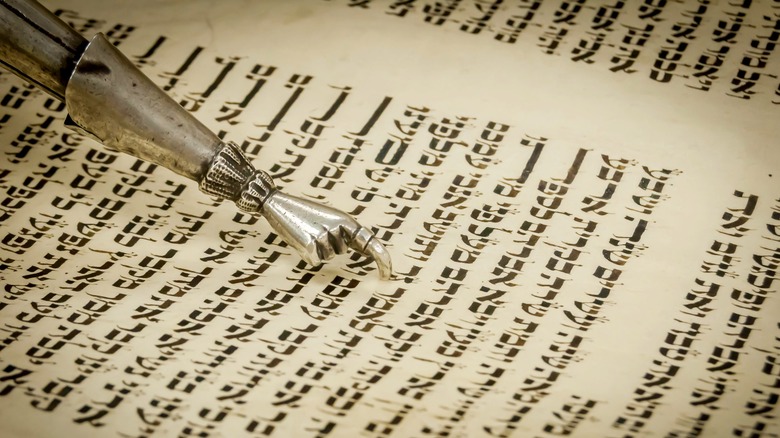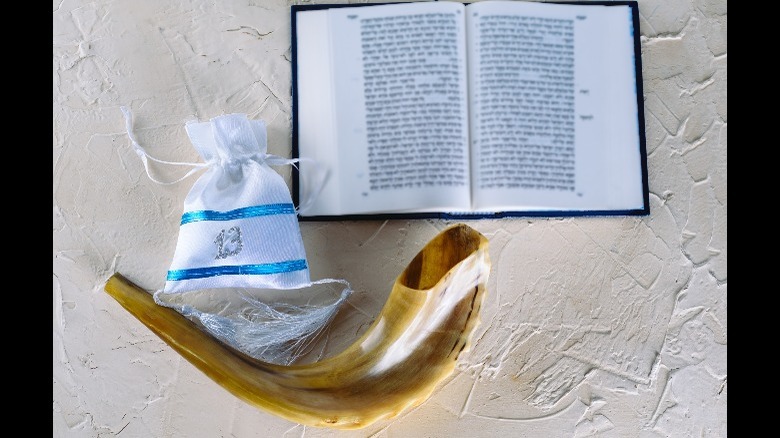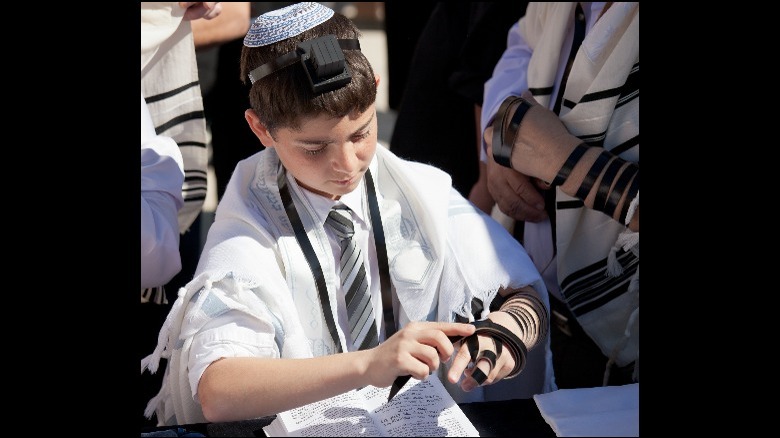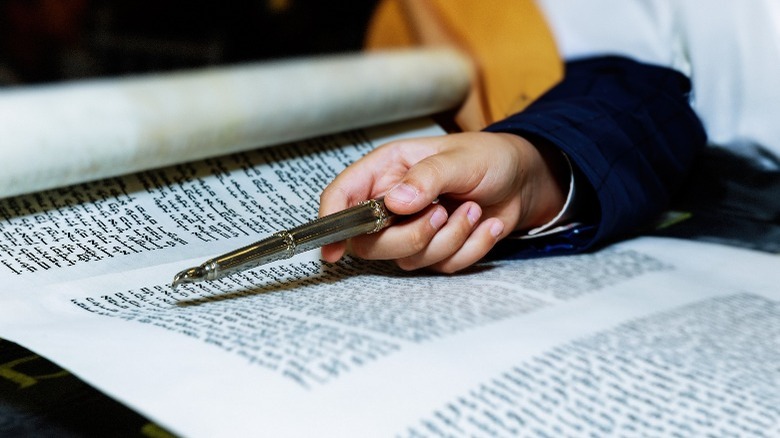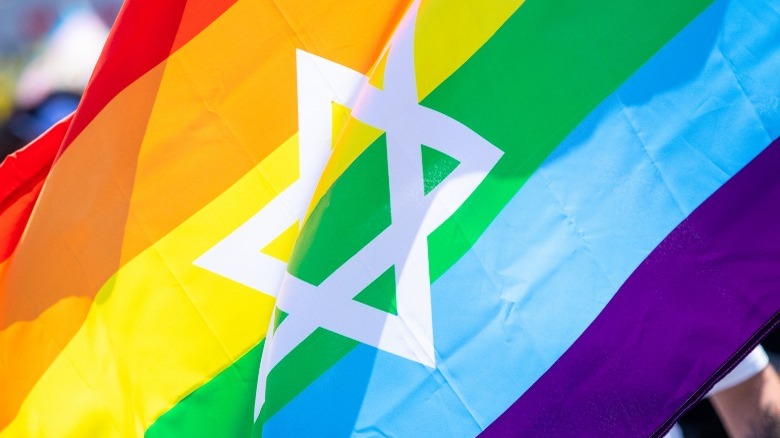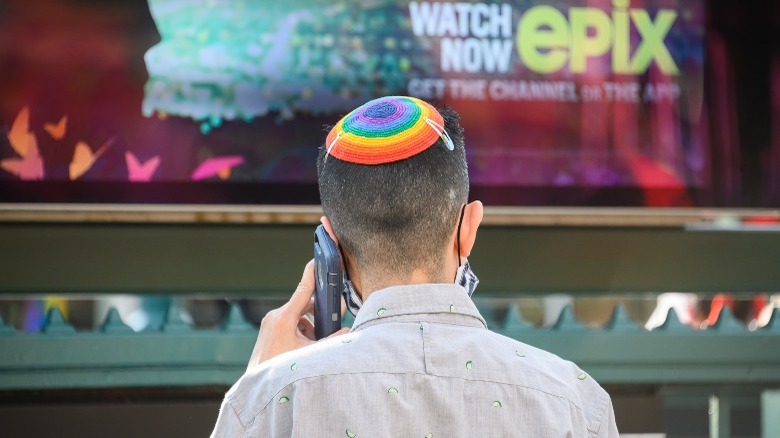What Do The Terms Bat Mitzvah, Bar Mitzvah, And B'nai Mitzvah Actually Mean?
While it might seem like bar and bat mitzvahs are a long-standing Jewish tradition, the truth may surprise you. Bat mitzvahs and a third variation, b'nai mitzvah, are actually recent concepts. According to My Jewish Learning, one way to translate "bar mitzvah" is "obligated to perform the Jewish mitzvot." The mitzvot are the commandments of Judaism found in the Torah, the first five books of the Bible. Jewish scholars agree that there are 613 total mitzvot, although their lists of individual commandments may vary slightly (via Jewish Virtual Library).
The terms "bar," bat," and "b'nai mitzvah" refer both to a coming-of-age ceremony and to the child who is going through that ceremony (via ReformJudaism.org). According to My Jewish Learning, the expectation of performing the mitzvot is a new responsibility for them, as younger children are not expected to adhere to the commandments. This is based on the idea that children are driven by impulses over which they don't have much control. At the age of 12 for girls and 13 for boys, children are expected to have more control of themselves.
What happens during the ceremony?
There are no specific rules for what should happen during a mitzvah aside from a parental blessing. Usually, the religious portion of a mitzvah happens during a Sabbath (Saturday) morning service. The child comes forward to say blessings over the Torah. This is called the aliyah. They may then participate in the rest of the service in various ways: by reading from the Torah, chanting the prophetic haftarah, and giving a d'var Torah, a speech in which they interpret that day's Torah reading. The child usually prepares for this for a year prior to the ceremony (via My Jewish Learning).
This religious ceremony is often followed by a party — typically a meal called a s'udat mitzvah. This tradition began in the Middle Ages, according to ReformJudaism.org. The way individual families celebrate varies. Sometimes, in addition to a meal, it can involve traditional dancing and giving money to charity, an act called tzedakah.
The meaning and history of bar mitzvah
Bar mitzvah is the term for boys who are coming of age. It means, more specifically, "son of the commandment." According to ReformJudaism.org, the term comes from Aramaic, in which bar means "son of," corresponding to the word ben in Hebrew. Along with My Jewish Learning, the outlet says that the ceremony also dates to the Middle Ages, first being recorded between the 13th and 16th centuries. Prior to that, boys were allowed to perform Jewish rituals as soon as they were old enough to understand them and be able to carry them out. Later, this changed.
Before the bar mitzvah ceremony existed, coming of age for a Jewish boy was probably marked by his father reciting a blessing, the baruch she'p'tarani. This blessing thanks God for relieving the father from the burden of responsibility for his child's behavior. The reformed branch of Judaism stopped celebrating bar mitzvahs in the 1800s, but the tradition was later revived (via ReformJudaism.org).
The meaning and history of bat mitzvah
"Bat mitzvah" is the corresponding term for girls and means "daughter of the commandment." Because this term is more recent, it comes from Hebrew rather than Aramaic, according to ReformJudaism.org. Whereas the bar mitzvah tradition is hundreds of years old, the first bat mitzvah in the U.S. didn't happen until 1922, according to the Jewish Virtual Library. It was for Judith Kaplan, daughter of Rabbi Mordecai Kaplan, who founded Reconstructionist Judaism, which focused on adapting to the modern age. He hoped the implementation of bat mitzvahs would give women equal standing with men in Judaism. Bat mitzvahs did not become widespread in American Judaism until the 1960s.
Traditionally, Jewish women were not permitted to read from the Torah, which is an integral part of bar mitzvahs. Thus, the first bat mitzvahs usually happened during Friday night services, during which the Torah is not read. If held on a Saturday morning, the girl would read from a separate book rather than the Torah scroll. As bat mitzvahs became more popular, it raised the question of whether or not women should be allowed to read from the Torah at other services. Most Reform and Conservative Jewish congregations allowed this by the 1970s (via Jewish Virtual Library).
What is a b'nai mitzvah?
In recent years, the strictly gendered Hebrew terms used in bar and bat mitzvah services have posed problems for anyone who doesn't conform to the gender binary. Even beyond the name of the ceremony — son or daughter of the commandment — some of the other language used in the ceremony, such as the aliyah call, is gender-specific (via Keshet). Hebrew doesn't have a word for child — only girl and boy — but people have started to find ways around these issues (via The New York Times).
One solution is to call the service a "b'nai mitzvah." Keshet, an LGBT-centric Jewish organization, explains that "b'nai" is a plural masculine pronoun but is used for mixed-gender groups. This essentially changes the phrase to "they of the commandment." One New York family used this for their pangender child after seeing it used for twins. Groups like Keshet are working to raise awareness in the Jewish community about adaptations for non-gender-conforming people. One group, Eshel, is even tackling this issue in Orthodox Judaism, in which bar and bat mitzvah ceremonies are still quite different from each other. The executive director of Eshel told The New York Times that the change will likely come to that community as well.
Other gender-neutral options for mitzvahs
"B'nai" isn't the only option for people who want a more neutral name for their mitzvah. A gender-fluid New York teen explained to The New York Times that they simply used "b mitzvah" and found it very affirming as part of their coming-of-age experience. Aside from those two possibilities, Keshet lists a few others on their website. Using traditional Hebrew, they suggest "zera mitzvah" ("seed/offspring of the commandment"), "simchat mitzvah" ("joy of the commandment"), and "brit mitzvah" ("covenant of the commandment"). Another option is "ban mitzvah," which combines the Hebrew words for boy and girl ("ben" and "bat") to make a new one.
A hybrid English-Hebrew option is "they mitzvah." Using English instead of Hebrew in mitzvah services has been suggested as another way to make them gender neutral, though some fear this is straying too far from tradition, according to The New York Times. In Judaism, however, it seems traditions are still being made.
